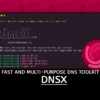Serpscan is a powerfull php script designed to allow you to leverage the power of dorking straight from the comfort of your command line.
Serpscan is a powerful PHP script designed to allow you to leverage the power of dorking straight from the comfort of your command line.
Serpscan offers powerfull use of (Google,Bing,Yahoo,Yandex,Badiu) search directives, by analyzing results from searches using multiple external tools.
You can run the tool in your PC or [VPS].
Features
- Scan multiple domains
- Subdomain Enumeration
- Checks alive subdomain
- Finds URLs from all search engines
- Finds js files
- Search endpoints in js files
- Finds parameters
- Finds directories
- Export results in html,json
- You can customize you dorks in config file

Installation
Prerequisites
| Name | Repository |
|---|---|
| subfinder | https://github.com/projectdiscovery/subfinder |
| httpx | https://github.com/projectdiscovery/httpx |
| hakrawler | https://github.com/hakluke/hakrawler |
Docker
Copy the commaand and use it for docker.
docker run -it alaa0x2/serpscan:latest php /usr/src/SerpScan/start.php -d domain.com -t html
Source code
git clone https://github.com/Alaa-abdulridha/SerpScan.git
cd SerpScan
chmod 777 install.sh
./install.sh
- You should add your SerpApi Key to the conf.php file
- You can grab your key from serpapi
- Also you can add your dorks to the config file without any problems
Usage
php serpscan.php -d target .com -t html
| Flag | Description | Example |
|---|---|---|
| -d | Domain to scan subdomains for | php start.php -d target.com -t html |
| -t | The template of result (html,json) | php start.php -d target.com -t html |
| -w | File containing list of domains to enumerate | php start.php -w domains.txt -t html |
Environment tested
- CentOS & Ubuntu By using the Install.sh
- Windows 10, by manually installation.
Results

SerpScan (this link opens in a new window) by Alaa-abdulridha (this link opens in a new window)
Serpscan is a powerfull php script designed to allow you to leverage the power of dorking straight from the comfort of your command line.

